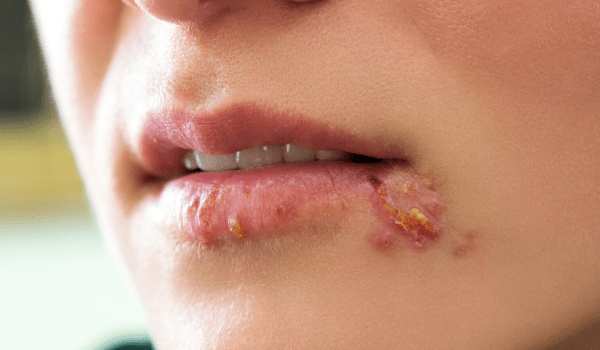Can you name the difference between a fever blister vs a cold sore? You might not be able to. This is because they’re actually (almost) the same thing with different names. Fever blisters and cold sores are a group of small blisters that occur on the lip and/or around the mouth. The blisters can be painful and may break open, causing a clear liquid to ooze out. Without immediate treatment, fever blisters and cold sores can take 8-10 days to heal completely. They have the same cause but slightly different triggers. Let’s find out what that means.
What’s The Same Between A Fever Blister and a Cold Sore?
Fever blisters and cold sores are caused by the herpes simplex type 1 virus (HSV-1). Most people who have HSV-1 contracted the virus when they were infants. However, HSV-1 can be spread through kissing, touching the person’s skin, and sharing silverware, drinks, lip balm, and other items commonly used around the mouth.
Once you have HSV-1, the virus stays in your system for the rest of your life. The virus can lay dormant for periods of time but can be triggered by several things that provoke an immune system response. Some of the same triggers include sickness, stress, sun exposure, menstrual periods, and surgery.
What’s The Difference Between A Fever Blister vs Cold Sore?
While fever blisters and cold sores have the same cause (HSV-1), the triggers related to the immune system response can be different. Fever blisters are outbreaks commonly associated with a fever while cold sores are commonly associated with colds. No matter the name, however, the treatment is the same.
How to Treat a Fever Blister or Cold Sore
You don’t have to leave your fever blister or cold sore untreated. While there is no cure for fever blisters or cold sores, this is one of the dermatological conditions we treat to help alleviate the symptoms and speed the healing process.
There are two options for treating fever blisters and cold sores: topical treatments and antiviral medications. Topical creams are antiviral treatments that can be applied directly to the affected area. Topical treatments can help relieve burning, itching, and tingling.
Dermatologists can prescribe oral or intravenous medications, or shots, to help quicken the healing process. Commonly prescribed medications include acyclovir, famciclovir, and valacyclovir. Taking these medications daily can decrease the severity and frequency of outbreaks, as well as help prevent the spreading of the cold sores.
Is That Fat Lip From a Cold Sore?
It could be! One of the most common symptoms of a fever blister or cold sore is fat lip. If you’ve recently been struggling with a fever, you may be dealing with a fever blister, while if you’ve recently had a cold, you may want to call it a cold sore.
Other Symptoms of Fever Blisters and Cold Sores
Even though there is not a cure for HSV-1, knowing your triggers and the signs of fever blisters and cold sores can help prevent them and treat them more quickly. The first symptom you may notice is a tingling or burning sensation around the mouth. A day or two following the burning and tingling, blisters will appear. While the most common places for HSV-1 to appear is on the lips or surrounding the mouth, blisters can also appear on the tongue, on the face, and anywhere else on the skin.
Other symptoms to watch out for include flu-like symptoms like fever, muscle aches, and swollen lymph nodes. HSV-1 can also spread to the eyes causing pain, light sensitivity, and discharge. HSV-1 symptoms can be treated with medical dermatology services, so contact your dermatologist immediately if any of these symptoms begin to interfere with your daily life.
Seek a Dermatologist
If you’re interested in learning more about how you can help prevent or quicken the healing process of your fever blister or cold sore, contact any of our Pittsburgh dermatology offices today or fill out a form below to schedule your appointment. Our board-certified dermatologists can help you create an individualized treatment plan that works for you.
Vujevich Dermatology Associates offers medical, surgical, and cosmetic dermatology from some of the most highly trained physicians and clinicians in the greater Pittsburgh area. You can reach our team at 412-429-2570 or visit our contact page to see all of our locations. You can also follow us on Facebook to see what’s new in the world of dermatology.

